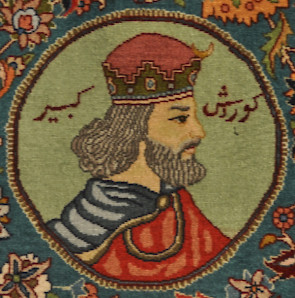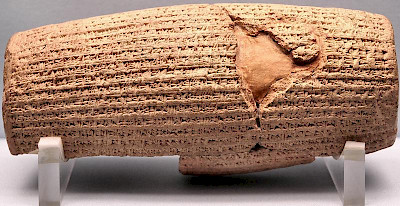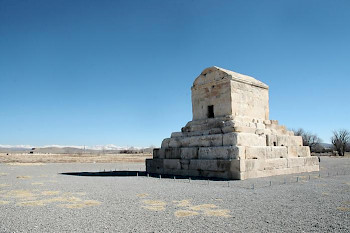Cyrus the Great
Cyrus (Old Persian Kuruš; Hebrew Kores): founder of the Achaemenid empire. He was the son of Cambyses I, the king of the Persian kingdom called Anšan. During Cambyses' reign, the Persians were vassals of the Median leader Astyages.
Persians and Medes

Expressions like "king of the Persian kingdom" and "the Median kingdom" are a bit misleading. The Medes and the Persians were coalitions of Iranian nomad tribes; in the fifth century, this was still remembered and the Greek researcher Herodotus of Halicarnassus wrote:
The achievement of Deioces [...] was to unite under his rules the peoples of Media - Busae, Parataceni, Struchates, Arizanti, Budii, Magi.The Persian nation contains a number of tribes [...]: the Pasargadae, Maraphii, and Maspii, upon which all the other tribes are dependent. Of these, the Pasargadae are the most distinguished; they contain the clan of the Achaemenids from which spring the Perseid kings. Other tribes are the Panthialaei, Derusiaei, Germanii, all of which are attached to the soil, the remainder - the Dai, Mardi, Dropici, Sagarti, being nomadic.note
These "kingdoms" were in fact losely organized tribal coalitions. In the first half of the sixth cenctury, the Median federation was the most powerful and was able to demand tribute from the Persians, but also from the Armenians, Parthians, Drangians and Arians.
Cyrus became king of Anšan in 559, and formed a new coalition of his own tribe, the Pasargadae, together with the Maraphii, Maspii, Panthialaei, Derusiaei, Germanii, Dahae, Mardi, Dropici and Sagarti. They revolted in 550 (or 554/553 according to another chronology).
Overcoming the Medes
The Median king Astyages sent an army to Anšan. It was commanded by Harpagus, but he defected to the Persians. Astyages was captured, his army was - according to Herodotus - badly scattered,note and Cyrus became the new ruler of the empire of Persians and Medes. According to the Greek topographer Strabo of Amasia, who lived more than five centuries later, Cyrus' victory took place among the Pasargadae, where Cyrus built his residence. From now on, this tribal name became the name of a city.
According to Herodotus, Cyrus' father Cambyses had been married to Astyages' daughter Mandane.note This would explain why the Medes accepted Cyrus' rule; he was one of them. Intertribal marriages were common, but it is also possible that the story of Cambyses' Median marriage was invented to justify Cyrus' rule. The Greek historian Ctesias of Cnidus writes that Cyrus also married a daughter of Astyages. If both authors are right, this woman must have been Cyrus' aunt.
Taking over the loosely organized Median empire also implied taking over several subject countries: Armenia, Cappadocia, Parthia, Drangiana, Aria. They were probably ruled by vassal kings called satraps. It is plausible that Elam was an early addition.
Anatolia
In c.547, Cyrus defeated the Lydians in the Battle of Sardes and added Lydia to his possessions, a state that had among its vassals the Greek and Carian towns in the west and southwest of what is now Turkey. A part of the population appears to have been deported to Nippur in Babylonia, where a community of Lydians is recorded in the Murašu Archive.
In these days, Cyrus may have awarded privileges to the shrine of "the Persian Artemis", Anahita, in the town that was later known as Hierocaesarea.note This source is, of course, quite young.
Eastern conquests
According to Herodotus, Cyrus left Lydia and "his mind was on Babylon and the Bactrians and the Sacae and the Egyptians".note It is certain that Cyrus never invaded Egypt, which was left to his son and successor Cambyses. However, it is possible that he added Cilicia to his dominions, making the local ruler, the Syennesis, a vassal king. Babylonian sources do not mention imported Cilician iron after 545 - which may be signicant.

It is plausible that Cyrus did indeed, as Herodotus suggests, conquer Bactria, although there is no independent confirmation.
Babylonia
What we do know for certain is that in October 539, the Persian king took Babylon and captured its king Nabonidus. The capture of the city was easy, but the aftermath of the battle appears to have been violent: the Nabonidus Chronicle uses the expression iduk, "to kill, to massacre" to describe what happened to the defeated. It must be stressed that those massacred were the nišu, not the ummanu, the citizens and not the soldiers.
The Babylonian Empire had been large, and Cyrus now became ruler of Syria and Palestine as well. According to the Biblical book of Ezra, Cyrus allowed the Jews, who were exiled to Babylon, to return home. This may have been an attempt to fortify the empire's western border against possible Egyptian attacks. However, there are serious chronological problems, and the archaeological evidence suggests that the return of the Jews took place much later. The Cyrus Cylinder reports the return of Mesopotamian exiles. (The policy was pretty standard, cf. ABC 2, 15-17).
Other eastern campaigns
The second century Greek-Roman author Arrian of Nicomedia tells us in his book about Alexander the Great (the Anabasis) that Cyrus founded a frontier town in Sogdia; there is no reason to doubt this statement. The Greeks called this town Cyropolis ("town of Cyrus") or Cyreschata (a pun on the name of the king and the word "far away"); both names seem renderings of Kurushkatha, "town of Cyrus". The Sacae (or Scythians) lived between Bactria and Cyreschata, and there is nothing implausible in Herodotus' words that Cyrus subdued these tribes.
Another story by Arrian deals with Cyrus' expedition to India (text); probably, this story is also accurate, but we cannot be completely certain. If he did invade India, he had to control Gandara first, and it is certain that Cyrus managed to seize this country: in the Behistun inscription, it is mentioned in the list of countries that king Darius the Great inherited from earlier Persian kings. However, it seems equally certain that Cyrus did not conquer the Indus valley itself, because India is not mentioned in the Behistun inscription. Maybe his navy conquered Maka during this campaign.
Death
Cyrus' latest expedition took him to modern Uzbekistan, where he fought against a nomadic tribe called Massagetes. If we are to believe Herodotus, Cyrus was defeated by a queen named Tomyris.note There are several other traditions about the death of the great conqueror – for example, according to Ctesias he was killed in Indianote and according to Xenophon he had a peaceful death in his palace.note
News of his death reached Babylon in December 530, where letters were dated 'first year of the reign of king Cambyses', because Cyrus had appointed his son Cambyses as his successor. (The mother of Cambyses was Cassadane, a sister of Otanes, who was to play an important role after the death of Cambyses.)

Cyrus was buried near Pasargadae, in a small building containing a gold sarcophagus, his arms, his jewellery and a cloak. This cloak played an important role in the Persian inauguration ritualsnote. When Persia was subjected by the Macedonian king Alexander the Great, many sacred objects were taken away to prevent the coronation of an anarya, a foreigner; Cyrus' body was desacrated by throwing it on the ground. Alexander ordered restorations in January 324 BCE.
Cyrus' capital was Pasargadae, where inscriptions in his palace state Cyrus the Great King, an Achaemenid. They were probably written during the reign of Darius I the Great, and it is uncertain whether the two kings really belonged to the same family.
Literature
The most important sources documenting the reign of Cyrus are the contemporary Chronicle of Nabonidus and the Cyrus cylinder. The first book of the Histories by the Greek researcher Herodotus is also very important, but legends and fairy tales sometimes obscure the historical facts. The book known as Education of Cyrus by the Athenian author Xenophon (c.430-c.355) is a vie romancée that contains no historical information.
- E. Badian, "Alexander the Great between two thrones and Heaven: variations on an old theme" in: Alastair Small (ed.), Subject and Ruler: the Cult of the Ruling Power in Classical Antiquity (1996)
- Diana Edelman, The Origins of the 'Second' Temple (2005)
- Amélie Kuhrt, "The Cyrus Cylinder and Achaemenid Imperial Policy" in: Journal for the Study of the Old Testament 25 (1983) 83-97
- R.J. van der Spek, “Cyrus the Great, Exiles, and Foreign God: a Comparison of Assyrian and Persian Policies on Subject Nations”, in: M. Kozuh e.a. (eds.), Extraction and Control. Studies in Honor of Matthew P. Stolper (2014) 233-266